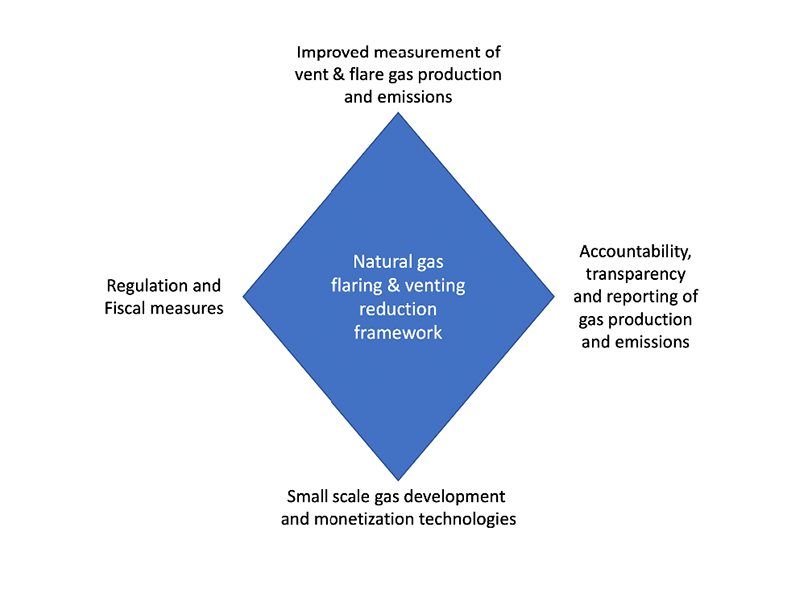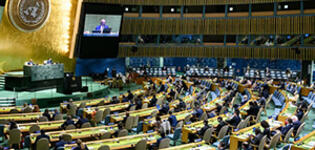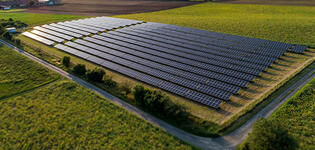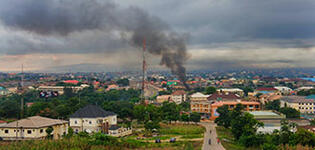Blog
Reducing wasted gas emissions is an opportunity for clean air and climate
The 2021 United Nations Climate Change Conference (COP26) is seen as the last best chance for countries and companies to set out how they are actually going to deliver the Intergovernmental Panel on Climate Change’s (IPCC) target of no more than 1.5 oC.
The venting and flaring of natural gas, common in the oil and gas industry, is one important area for action. 5.2% of total global anthropogenic greenhouse gas (GhG) emissions and 7.2% of global energy GhG emissions register as fugitive emissions —of which gas flaring and venting form a large part. These practices also release methane and other toxic chemicals that degrade air quality and harm human health.
Our recent research provides a framework to integrate multiple natural gas flaring and venting data sources. Together these data demonstrate major opportunities to help meet the nationally-determined contributions (NDCs) of developing countries, improve human health, and provide revenue for governments and energy access for communities by repurposing flared and vented natural gas for power generation and fuel (e.g. compressed natural gas).
Gas flaring and venting is a waste
7.5% of all gas extracted is flared or vented by the industry, instead of captured for sale, reinjected into the ground, or used to power onsite operations. Flaring refers to the controlled burning of the gas and venting refers to simply releasing it into the atmosphere. Both practices waste a non-renewable economic resource.
Globally, if even three-fourths of the gas flared and vented were captured and sold instead, it would provide additional natural gas sales value of up to US$40 billion per annum (assuming an average gas price of US$4/MMBtu). If all global natural gas flared and vented was captured and brought to market, it could supply all of South and Central America’s gas consumption and all of Africa’s power needs annually.
A solutions framework
Technologies to capture and use gas instead of flaring and venting are available and affordable, but are often not adopted by oil and gas companies when this would dilute their commercial returns or result in projects with limited financial scale. However, a successful example is Norway. Public policies —regulation requiring measurement of emissions, together with fiscal measures— have changed the calculus for the companies involved. Its prohibition on routine gas flaring and venting has made Norway a leading country on implementing small-scale gas monetization technologies (such as mini-Liquefied Natural Gas for transport).
Our integrated Diamond Model outlines the four elements for public-private collaboration needed to reduce gas flaring and venting: (1) improved measurement of vent and flare gas production and emissions, (2) accountability, transparency, and reporting of emissions, (3) gas development and monetization technologies, and (4) regulation and fiscal measures.
Figure 1: The Diamond Model to end routine flaring and venting

Improved measurement and transparency
Most developing countries lack knowledge about the volume and location of gas flares and vents and most oil and gas companies do not measure these rates. Satellite data offer a way forward, as Nigeria demonstrates. In 2005, Nigeria was the world’s second-largest gas flaring nation, but by 2019 it was seventh. This progress is partly due to the innovative, transparent, and publicly available Gas Flare Tracker.
The Gas Flare Tracker, which was developed under the Foster programme and financed by UK’s Foreign Commonwealth and Development Office (FCDO), helps the Nigerian government to measure flare data for all its upstream oil and gas operations. Nigeria then sets penalties for flaring at levels that are a realistic deterrent. The Nigerian Gas Flare Regulation, approved in 2018, raised the penalty from US$0.10 to US$2 per thousand standard cubic feet (kscf) of gas flared or vented. Initial analysis suggests that the policy raised additional revenues of US$120 m in 2019. The penalty was raised again in 2019 to US$3.50/kscf with an estimated increase in revenues of US$270 m.
Satellite data are also especially important in identifying and acting on ‘super-emitters’ —61% of all gas flared globally comes from just 6.6% of flares. The small number of very large, super-emitting flares are an obvious target for reductions (see Figure 2). Future work utilizing satellite data is urgently needed to assess where large flare eradication will have the biggest impact in terms of emissions volume reduction and gas commercialization.
Figure 2: Number and volume of measured gas flares worldwide
Additional opportunities, which we discuss in our WIDER Working Papers, include using the Social Cost of Atmospheric Release (SCAR) to better assess the emissions impact of a variety of chemicals. This approach leads to the insight that emission volumes should not be wrapped in a CO2-equivalent measure because different chemical emissions affect climate, air quality, health, and environment differently. A CO2-equivalent measure obscures the large part of the costs of chemical emissions that are not climate-related, an important component of gas flaring emissions (see Figure 3).
Figure 3: SCAR of global gas flaring and venting
Small scale gas development & regulation and fiscal measures
Ranking of flares and vents, by volume and pollutants emitted, supports the eradication of super-emitters AND identifies those flares and vents that provide the best financial and economic returns if the gas is monetized. By combining analysis of small-scale gas monetization options, indicative costs of each technology, and satellite measurement data, gas commercialization projects can be identified that improve health, food security, and energy access for communities.
Several recent technological developments now enable commercial gas projects that are much smaller in size and lower in cost due to designs that are scalable, modular, and optimized for containerized and truck-mounted applications.
Governments can generate fiscal revenue and target regulation by using satellite data on gas flares, as Nigeria shows. Furthermore, fiscal measures on flaring and venting can lower the commercial breakeven cost and encourage companies to repurpose their waste gas for use.
Finally, many oil and gas producing countries could also meet or exceed their NDCs by eliminating routine natural gas flaring. Yemen, Algeria, and Iraq can exceed their NDCs this way. Gabon, Algeria, Venezuela, Iran, and Sudan can make a substantial contribution to them. The solutions to stop routine flaring and venting are available, and their implementation can help oil and gas producing countries move swiftly on their Paris commitments and contribute significantly to key Sustainable Development Goals (SDGs) — including climate action, human health, and energy access — under the UN Agenda 2030.
The views expressed in this piece are those of the author(s), and do not necessarily reflect the views of the Institute or the United Nations University, nor the programme/project donors.
 Join the network
Join the network












